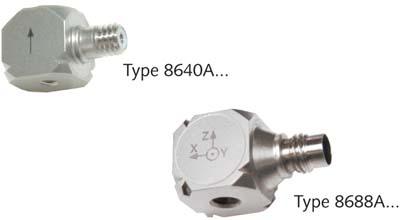
Kistler has announced the availability of its piezoelectric accelerometer technologies for cost-effective, high-accuracy support of aircraft, helicopter, rotorcraft, missile, satellite and unmanned aerial vehicle (UAV) ground vibration testing (GVT), as well as large-scale MIMO and SIMO aerospace structural monitoring.
Typical aerospace GVT requirements call for the use of high-performance piezoelectric accelerometers which offer a lower per channel cost, yet which are also compact and lightweight enough to reduce the effects of mass loading on the article under test. These transducers also must offer accurate frequency and phase response within its specified frequency range. Due to the large number of accelerometers in use, requirements also call for the use of IEEE P1451.4 Transducer Electronic Data Sheet (TEDS) capabilities, which are compatible with TEDS-compliant signal conditioning and data acquisition systems that minimize transcription errors and record keeping tasks. Among the technologies offered by Kistler, which are successfully used across thousands of GVT field installations.
The single axis Kistler Type 8640A is the company's dimensionally smallest, lowest mass PiezoBeam IEPE accelerometer, weighing just 3.5 grams, often specified for large-scale aircraft structural testing and monitoring, including modal analysis. Offered in ranges of +/-5 g, +/-10 g and +/-50 g, with sensitivities from 1000 mV/g to 100 mV/g, the sensor's ceramic cantilever beam sensing element is thermally compensated using patented methods, allowing it to emit an electrical charge when stressed during vibration exposure (World patent number W0/2007/062532; European Patent: 2006790940; U.S. patent number 12,088,325). The sensing element is enclosed within a hermetically sealed, welded titanium housing. This proprietary design provides low-impedance output with outstanding amplitude and phase response over a wide frequency range, with low base strain sensitivity and exceptional measurement stability. The single axis Kistler Type 8640A also features an integral 10-32 connector, as well as several mounting accessories, for easy installation into space constrained environments. Also available is the Kistler Type 8772A, a uniaxial PiezoSmart cube-shaped accelerometer, available in ranges of +/-5 g, +/-10 g and +/-50 g, with optional TEDS, for ease of use in larger channel applications.
For simultaneous vibration measurements in three orthogonal axes, Kistler offers the Type 8688A PiezoBeam IEPE triaxial accelerometer. It is the company's dimensionally smallest, lowest mass PiezoBeam model, weighing just 6.7 grams (for 1000 mV/g). Available in ranges of +/-5g, +/-10 g and +/-50 g, with choice of 1000 mV/g, 500 mV/g or 100 mV/g sensitivities, the globally patented Type 8688A (U.S. patent number 12,088,325) incorporates a ceramic cantilever beam sensing element enclosed within a lightweight, robust, welded titanium housing. Sensing elements are designed to provide outstanding amplitude and phase response over a wide frequency range and are temperature compensated using Kistler's own patented methods. Type 8688A sensors feature an integral low-noise charge amplifier that converts the charge signal to a proportional high-level voltage signal. Kistler Type 8688A triaxial accelerometers offer an industry standard 4-pin, ¼-28 connector, as well as several mounting accessories, facilitating easy installation into space confined areas, with ability to mount the sensor on any of its faces. Both single axis and triaxial models operate directly from the IEPE power source found in most FFT analyzers, Kistler Piezotron power supply couplers or any industry standard IEPE-compatible power source. Units are ground isolated when mounted with the optional twist-clip or adhesive adapter.
